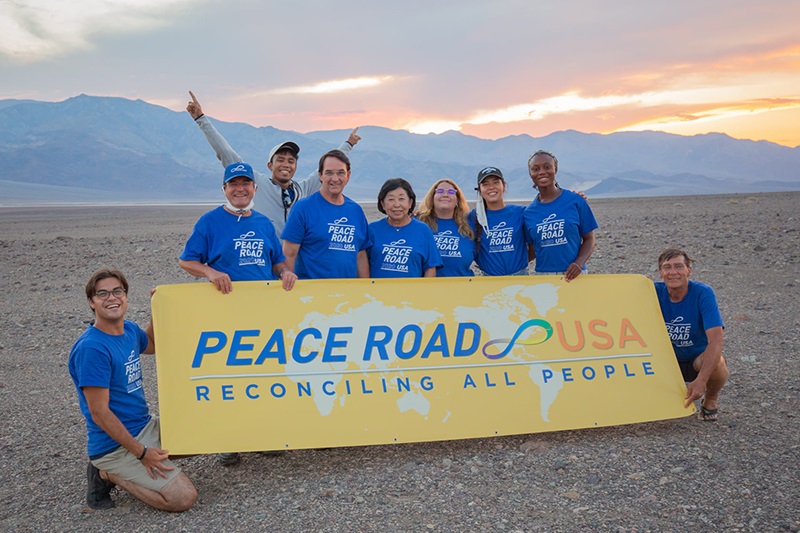The Road to Peace

The concept of Peace Road first began 40 years ago, in 1981, at a science conference in Seoul. This enduring vision of the late Rev. Dr. Sun Myung Moon, co-founder of Family Federation for World Peace and Unification (FFWPU), materialized in 2015 through his wife and FFWPU co-founder, Dr. Hak Ja Han Moon. Today, Peace Road celebrates the sixth year of its global launch on May 30.
The idea of Peace Road consists of an international highway that physically connects all people of the world together. Rev. Moon suggested the construction of a highway between Korea and Japan, two former enemy nations, and from 2005 onward he began to advocate a more ambitious project: the building of the “Peace Tunnel” to cross the Bering Strait between the Pacific and Arctic oceans.
“This tunnel can help make the world a single community at last,” said Rev. Moon in a 2005 speech at the United Nations in Geneva. “Think of how much money the world is wasting on war. The time has come for nations to work together, pool their resources and, as the prophet Isaiah taught, beat our swords into plowshares and pruning hooks.”
Throughout recorded history, humanity has built roads. Some, like the famed Silk Road from Europe to China, were created to foster trade, exploration, and cooperation. By contrast, the Roman road system was built to allow the Roman legions to administer a vast empire, leading to the saying “all roads lead to Rome.”
In 1956, U.S. President Dwight D. Eisenhower created today’s interstate system after experiencing the slow travel of the armed forces as a lieutenant-colonel in the U.S. Army. Meanwhile, across the Atlantic, British and French engineers toyed with the idea of a tunnel across the British Channel for almost 200 years before finally completing it in 1994. Yet, until Peace Road, there was never a road or highway specifically conceived and built as a highway to world peace.
Peace Road exemplifies Rev. Moon’s conviction that humanity is one family under God. He believed that if people could meet each other in daily life, through culture, trade, and travel, they would come to break down the historic fears and misunderstandings that often divide us from our closest neighbors.
In 2015, the 10th anniversary of Rev. Moon’s UN speech and the third anniversary of his ascension in 2012, Dr. Moon spearheaded the effort to rekindle interest in Peace Road. Thousands of peace supporters all around the world walked, rode, and drove the proposed course of the peace highway in honor of Rev. Moon’s memory and dream of peace.
In the U.S., annual Peace Road treks have spanned major cities along the West Coast all the way up to Anchorage and Nome, Alaska, on the coast of the Bering Sea. Supporters on the East Coast have biked to the United Nations Headquarters and the 9/11 Memorial in New York, and on Capitol Hill in Washington, D.C. Internationally, teams have converged in Germany, Austria, the United Kingdom, and even Rev. and Dr. Moon’s divided homeland of Korea, right on the 38th Parallel between the North and South.
“Peace Road is not just symbolic,” said U.S. Peace Road organizer, Rev. Miilhan Stephens. “We are bringing together public officials and faith leaders to promote peace during a time where this is essential.”
During summer 2020, a Peace Road bus tour across the U.S., “Reconciling All People,” spent four weeks visiting historical places in 26 states to promote peace and reconciliation. The Peace Road team sought to foster dialogue, unity, and prayerful encouragement in addressing suffering and injustice in America during the height of the pandemic. Politicians, clergy, law enforcement, and civilians came together at historical locations such as the Underground Railroad, Liberty Bell, the iconic Gateway Arch, the National Civil Rights Museum, the Washita Battlefield site, and more.
“This is an important place to come and repent for the misdeeds that happened here and the suffering that happened,” said Rev. Staffan Berg, outside Canyon de Chelly in Sedona, Arizona. The canyon was the site of an Apache exodus and the final battle between the U.S. Army and Navajo Indians in 1864.
Another tour stop, Little Rock Central High School in Little Rock, Ark., is the historic site where nine black students were denied enrollment there in 1957, sparking a national crisis. “People from all over the South who were opposed to their enrollment came here,” said Bruce Biggin, Universal Peace Federation (UPF) regional secretary general. “Eventually, after the school was integrated, this was a victory and success for integrating schools throughout America.”
Peace Road 2020, which began at Plymouth Rock in Plymouth, Mass., and included 33 cities, came to an end nearly 4,000 miles away on the shores of the Bering Strait. The Peace Road 2021 program is currently in development.
You can learn more about Peace Road here, and stay tuned for more information.
Comments are welcomed and encouraged on this site, but there are some instances where comments will be edited or deleted. Please see our comments policy here.
